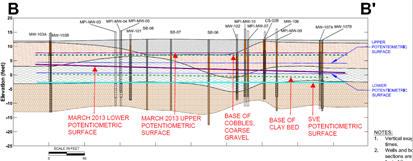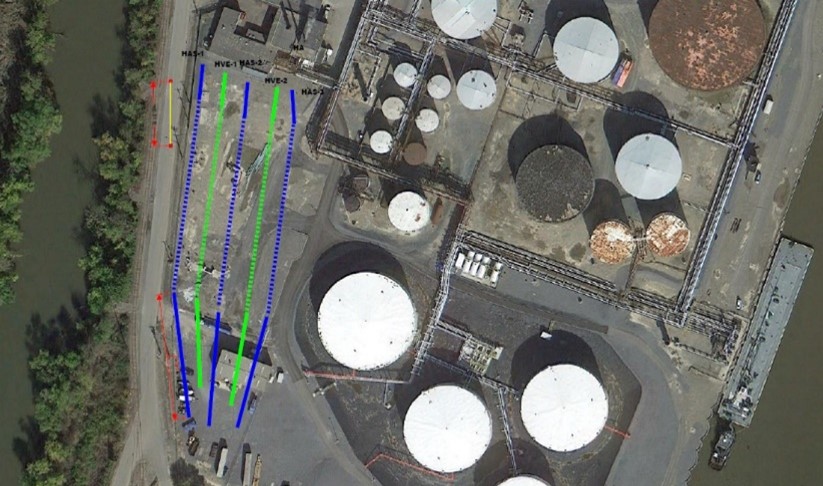Very Uncommon Site Conditions Addressed by Custom Designed AS/SVE Horizontal Wells
Project Background
A large groundwater plume migrating towards adjoining sensitive surface waters, complex glacial geology, dramatic tidal influences, and a busy facility with limited open space presented significant remediation challenges. An experienced consultant had been brought in to deal with a challenging petroleum remediation project at the fuel terminal facility. The site had been extensively characterized in order to help identify the most effective means of successfully carrying out the remediation. It was now up to the consultant to figure out a solution that could successfully overcome the tough site conditions and remediate the extensive soil and groundwater contamination at the project site. Through their expertise and innovative thinking, they were able to formulate a remediation plan incorporating horizontal remediation wells that could overcome the various challenges at their project site.
Geologic and Hydrologic Setting
The site was subject to significant tidal fluctuations which caused the groundwater elevation to vary over an interval exceeding 12 feet. These tidal fluctuations had a significant influence on LNAPL mobility and recoverability. Characterization of the site revealed that the LNAPL was distributed among three stratigraphic units with differing saturation rates within each unit. The uppermost unit consisted primarily of medium to coarse sand, the intermediate unit consisted primarily of sandy silt and clay with lenses of silty fine sand, and the lowermost unit consisted primarily of silty fine sand. Findings from previous investigations indicated that LNAPL near the top of the water table was near its residual saturation while the LNAPL in the deeper semi-confined strata had low-to-moderate mobility. Hydraulic conductivities widely varied from 0.021 feet per day to 3.25 feet per day. LNAPL recoverability was determined to be highest in the lowermost unit.

Biggest Challenges
The consultant’s largest challenges included:
- A large contaminant plume was migrating toward surface water resources
- Complex geologic setting
- Complex hydrologic setting
- Extensive smear zone
- Active facility with limitations on the placement of vertical wells
Solution
During the consultant’s process of evaluating different remedial approaches, they reached out to the remediation experts at Directional Technologies to determine if horizontal wells could potentially be the best way to address their challenges. Working together, they identified that a system combining the use of horizontal air sparge and soil vapor extraction (AS/SVE) wells could be effective at addressing the contaminants in the upper saturated soils as well as the more mobile LNAPL in the deeper strata. In addition, the horizontal wells could be used to place the system beneath existing facility infrastructure and avoid causing interruptions to facility operations.

Implementation
The horizontal AS/SVE remediation system consisted of three deep AS wells and two shallow SVE wells. The deeper SVE wells were installed at an average depth of approximately 32 feet BGS to target the semi-confined layer of silty fine sand. To provide vadose remediation and recovery of the vapors from the volatilized LNAPL from the lower strata, the two horizontal SVE wells were installed in the uppermost stratigraphic unit at target depths of 4 feet BGS. Each horizontal well contained 300 feet of screen in direct contact with the most highly concentrated portions of the contaminant plume. The AS screens were designed for air injection rates of 0.5 scfm per foot of screen and the SVE wells were designed for vapor extraction rates of 1.5 scfm per foot of screen. The horizontal wells were 4-inch diameter with custom-engineered site-specific screen designs to achieve the desired airflow rates. The designs incorporated a variable percent open area across the length of the screen to achieve these goals.
With their new horizontal AS/SVE system in place the consultant was able to:
- Overcome the complex geology and hydrology of their site.
- Install the system in critical areas of the plume without impeding facility operations.
- Accelerate remediation of the site by having an extensive interface between the well screen and the large contaminant plume.
How do you evaluate remedial options when there are multiple factors that make remediation difficult? Call our horizontal remediation well experts at 1-877-788-4479 to discuss your current project needs.